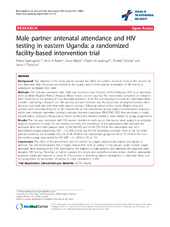| dc.contributor.author | Byamugisha, Robert | en_US |
| dc.contributor.author | Åstrøm, Anne Nordrehaug | en_US |
| dc.contributor.author | Ndeezi, Grace | en_US |
| dc.contributor.author | Karamagi, Charles A. S. | en_US |
| dc.contributor.author | Tylleskär, Thorkild | en_US |
| dc.contributor.author | Tumwine, James K. | en_US |
| dc.date.accessioned | 2012-01-18T14:59:19Z | |
| dc.date.available | 2012-01-18T14:59:19Z | |
| dc.date.issued | 2011-09-13 | eng |
| dc.Published | Journal of the International AIDS Society 2011, 14:43 | en |
| dc.identifier.issn | 1758-2652 | |
| dc.identifier.uri | https://hdl.handle.net/1956/5471 | |
| dc.description.abstract | Background: The objective of the study was to evaluate the effect of a written invitation letter to the spouses of new antenatal clinic attendees on attendance by couples and on male partner acceptance of HIV testing at subsequent antenatal clinic visits. Methods: The trial was conducted with 1060 new attendees from October 2009 to February 2010 in an antenatal clinic at Mbale Regional Referral Hospital, Mbale District, eastern Uganda. The intervention comprised an invitation letter delivered to the spouses of new antenatal attendees, while the control group received an information letter, a leaflet, concerning antenatal care. The primary outcome measure was the proportion of pregnant women who attended antenatal care with their male partners during a follow-up period of four weeks. Eligible pregnant women were randomly assigned to the intervention or non-intervention groups using a randomization sequence, which was computer generated utilizing a random sequence generator (RANDOM ORG) that employed a simple randomization procedure. Respondents, health workers and research assistants were masked to group assignments. Results: The trial was completed with 530 women enrolled in each group. Participants were analyzed as originally assigned (intention to treat). For the primary outcome, the percentage of trial participants who attended the antenatal clinic with their partners were 16.2% (86/530) and 14.2% (75/530) in the intervention and nonintervention groups, respectively (OR = 1.2; 95% CI: 0.8, 1.6). For the secondary outcome, most of the 161 male partners attended the antenatal clinic; 82 of 86 (95%) in the intervention group and 68 of 75 (91%) in the nonintervention group were tested for HIV (OR = 2.1; 95% CI: 0.6 to 7.5). Conclusions: The effect of the intervention and the control on couple antenatal attendance was similar. In addition, the trial demonstrated that a simple intervention, such as a letter to the spouse, could increase couple antenatal clinic attendance by 10%. Significantly, the majority of male partners who attended the antenatal clinic accepted HIV testing. Therefore, to further evaluate this simple and cost-effective intervention method, adequately powered studies are required to assess its effectiveness in increasing partner participation in antenatal clinics and the programme for prevention of mother to child transmission of HIV. | en_US |
| dc.language.iso | eng | eng |
| dc.publisher | BioMed Central | eng |
| dc.relation.ispartof | <a href="http://hdl.handle.net/1956/7333" target="blank">The prevention of mother-to-child transmission of HIV programme in Eastern Uganda. Men’s involvement in a changing HIV testing policy context</a> | eng |
| dc.rights | Attribution CC BY | eng |
| dc.rights.uri | http://creativecommons.org/licenses/by/2.0/ | eng |
| dc.title | Male partner antenatal attendance and HIV testing in eastern Uganda: a randomized facility-based intervention trial | en_US |
| dc.type | Peer reviewed | |
| dc.type | Journal article | |
| dc.description.version | publishedVersion | en_US |
| dc.rights.holder | Copyright 2011 Byamugisha et al; licensee BioMed Central Ltd. | |
| dc.identifier.doi | https://doi.org/10.1186/1758-2652-14-43 | |
| dc.identifier.cristin | 882945 | |
| dc.subject.nsi | VDP::Medical disciplines: 700::Health sciences: 800::Community medicine, Social medicine: 801 | eng |
| dc.subject.nsi | VDP::Medical disciplines: 700::Health sciences: 800::Health service and health administration research: 806 | eng |

